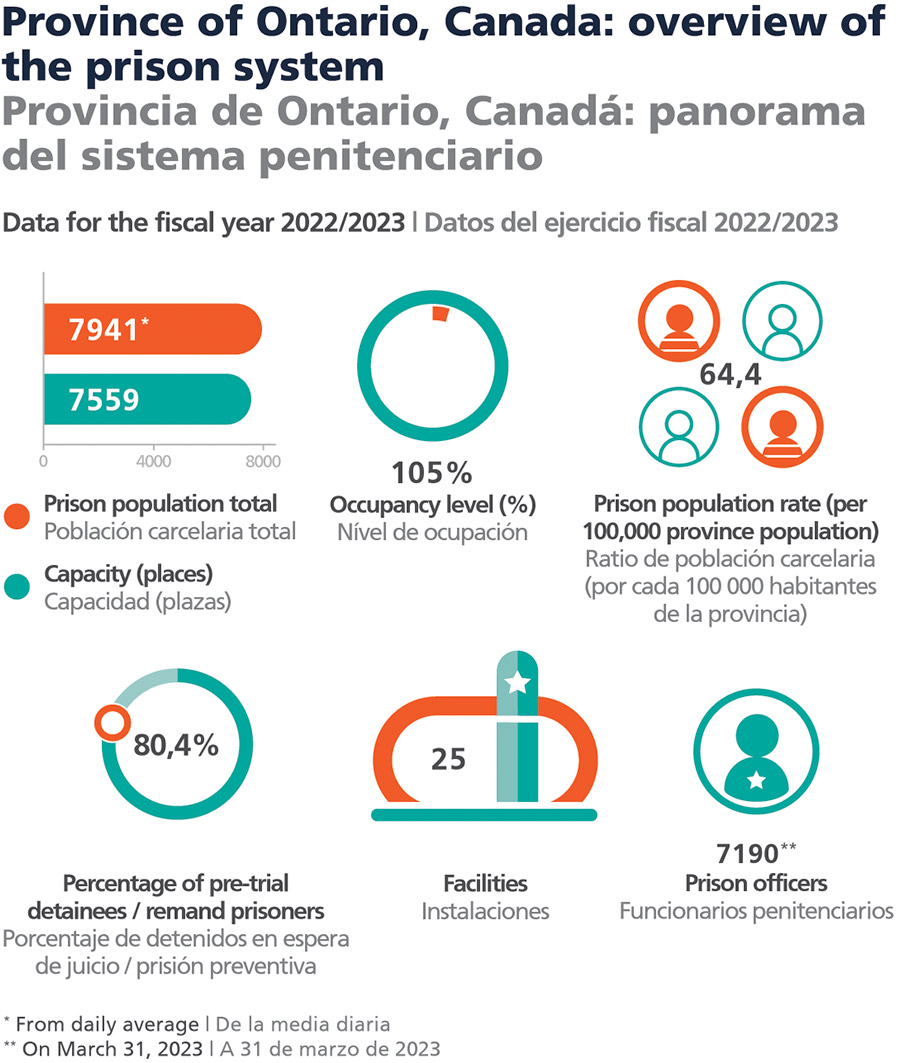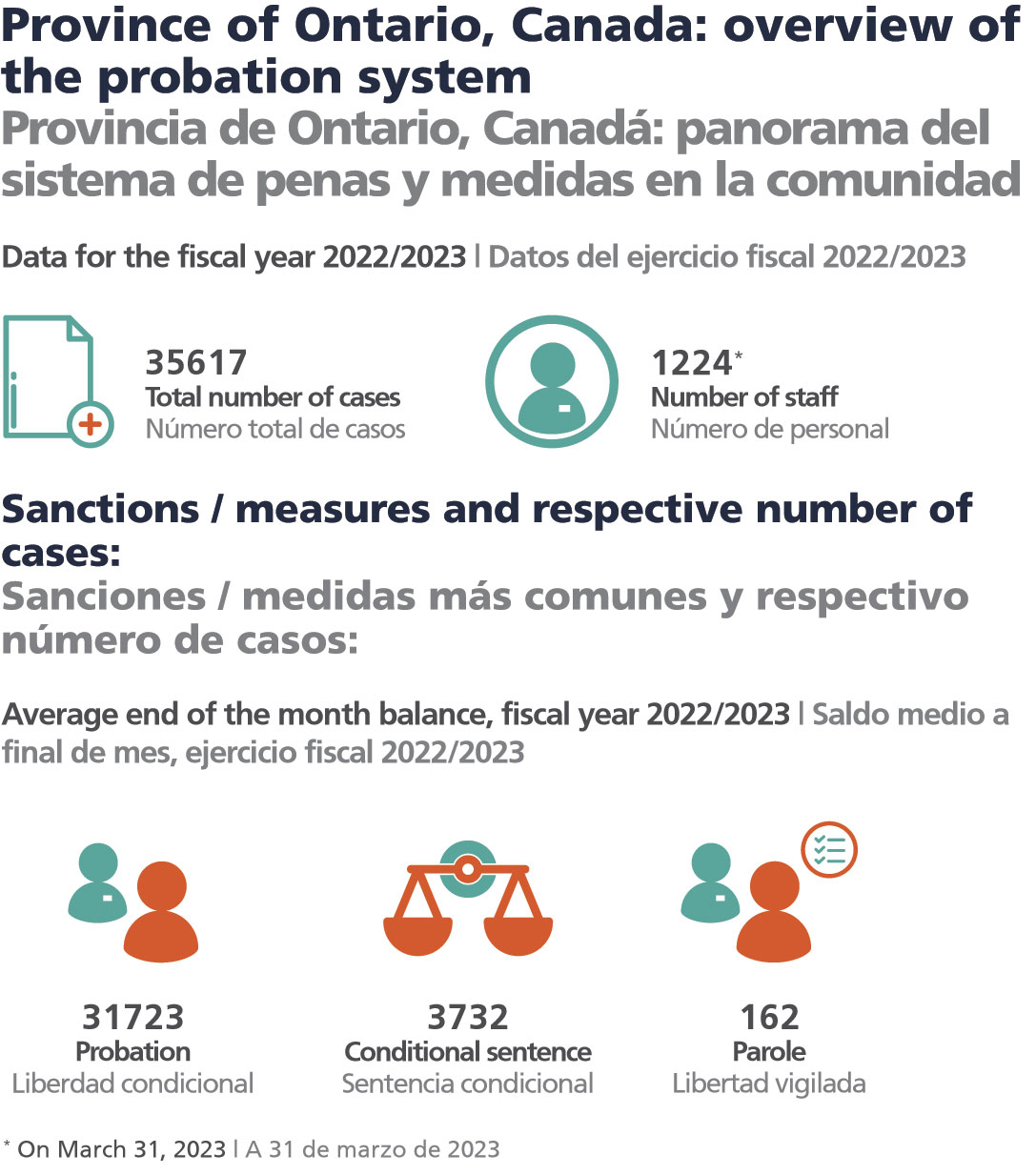Interview
Karen Ellis
Deputy Solicitor General, (Correctional Services), Ontario, Canada
The administration of correctional services in Canada involves a complex interplay among federal, provincial, and territorial governments, each with distinct areas of jurisdiction. Provincial and territorial correctional services programs are responsible for managing adults serving custodial sentences of less than two years, individuals held while awaiting trial or sentencing, and those under community sentences.
This interview will focus on the provincial perspective, specifically examining Ontario’s progressive strategy for modernizing correctional facilities and services. This strategy encompasses construction, renovations, and advancements aimed at addressing issues like overcrowding, enhancing mental health services, improving inmate programs and community reintegration, and elevating staff training.
Taking the provincial reins, the Ministry of the Solicitor General assumes responsibility for Correctional Services, whose evolution has been guided by Deputy Solicitor General Karen Ellis for the last two years.
In light of the ongoing modernization agenda for the Ontario Correctional Services, could you elaborate on the core challenges you’ve identified and the steps that are being taken to address those challenges?
KE: We are a very important piece of a much larger ecosystem in the justice sector, and we must make sure that the part of the system we run is safe, effective, and accountable. This is very much the focus of all the training and all the work that we do in the Correctional Services space.
Ontario’s correctional system faces long-standing challenges, including our physical infrastructure and capacity, lack of technology, and evolving expectations of accountability, transparency, and treatment of often confidential or sensitive data, to name a few.
There has been an increase in the number of people in custody who are on remand, related to a court backlog coming out of the COVID-19 pandemic, and recent efforts by the courts, and provincial and federal governments to crack down on individuals that are charged with additional criminal offences while in the community on bail. These factors have contributed to increasingly high custodial counts of people on remand which puts pressure on the correctional system. Among our incarcerated population, upwards of 80% are on remand, and they are in our custody for an average period going beyond 60 days. We need to work with these individuals and try the best we can in terms of programming and discharge support.
We are investing more than $500 million over 5 years to modernize correctional services and improve health and safety through new hiring and infrastructure improvements. New construction and infrastructure upgrades will alleviate capacity pressures and create additional space for enhanced programming and community reintegration supports. We are working to support infrastructure improvements across the province to increase our capacity to run video courts from institutions.
The ministry also has a great deal of important work underway to strengthen healthcare services and improve safety, security, and accountability across the board. We are investing in recruitment, retention, and training for frontline staff including correctional officers and probation and parole officers, social workers, mental health nurses, rehabilitation officers, recreation officers and managers, enabling improvements in service delivery.
While in custody offenders and accused persons on remand can access rehabilitation and support programs that aim to improve outcomes as they reintegrate back into the community.
There is also work underway to promote community safety and supervise individuals serving their sentence within in the community effectively, including those bound by probation, conditional sentences or parole conditions. The professional team of Probation & Parole Officers (PPOs), support staff, and managers, work throughout the province to keep communities and victims safe by providing people centred support, to over 38,000 clients – with dignity, with inclusion, and accountability.
Supporting individuals to successfully re-enter their community is an important step in contributing to the reduction of recidivism and maintaining public safety. We help clients make changes by offering rehabilitative programming and referrals to necessary services, with a balanced approach to enforcement. We are an important contributor in the justice sector, as we assess and mitigate risk, post-sentence, and assist with community reintegration.
It’s crucial that our staff and teams effectively navigate both aspects of our mandate, and that’s why we’re so focused on leadership development as well.

JT: A report by the Office of the Auditor General of Ontario indicated that “rehabilitative treatment and programming, discharge planning, and the living conditions in the institutions were not sufficient to increase inmates’ chances of reintegrating positively into the community.”
Could you discuss the measures that have been implemented to address the issues identified by the Auditor General of Ontario?
JT: Last year the Ontario Government set up new teams specialising in Institutional Security in correctional facilities.
Can you provide insights into the reasons behind the inception of these teams and how they contribute to the broader agency objectives?
We also have Field Intelligence Officers, who together with the ISTs gather information within facilities to identify potential threats, prevent drug trafficking and detect contraband items both in the Institutions and in the community through collaboration with various stakeholders.
Correctional officers are trained in recognizing signs of gang affiliations and activities, and we have information sharing protocols in place with police services.
How have the modernization efforts aligned with the need to address issues like organized crime and radicalization in correctional institutions?
Under the auspices of the Correctional Services Oversight and Investigations Unit the ministry operates the Ontario Corrections Intelligence Unit, which has Field Intelligence Officers (FIOs) who work in various facilities across the province along with Intelligence Analysts. This unit identifies, analyses, monitors, and advises on information and intelligence matters within the correctional system.
The ISTs and the Ontario Corrections Intelligence Unit connect with other policing and intelligence partners in priority areas such as gang affiliation, gun and gang violence reduction – which is obviously connected to organized crime to a large degree – as well as human trafficking.
We have begun a phased implementation of a modernized reporting tool to digitally track and report on incidents in institutions and community service sites. The new system will improve the consistency, accuracy, timeliness, and efficiency of incident reporting, allowing us to track critical statistics and trends that we can then share with partners in the justice system.
As part of our Contraband Strategy and Action Plan announced in June 2021, the government made regulatory changes to enhance screening and searches of everyone entering the secure area of correctional institutions, including staff, visitors, contractors, and volunteers.
That has been an important step in the Contraband Strategy and Action Plan, which has also included the installation of new security technology such as additional ion scanners to detect and identify trace elements of drugs, and cell phone detectors to detect and locate contraband cell phones.
We are also currently working on drone detection systems that will be piloted soon, to prevent delivery of contraband onto institutional property.

Looking ahead to the near future, what key challenges do you perceive will be faced by Ontario Correctional Services?
KE: The work we are doing in infrastructure will continue to be critical. Improving the quality of correctional health care, encompassing physical, mental health, and addiction services, will be sustained as a top priority. We established a dedicated Health Services Division this past spring to improve the quality of healthcare services for inmates in custody, and we are going to be focused on strengthening clinical practice and independent oversight of healthcare resources and staff.
We are working on moving to electronic medical records, which includes big transformative steps, and working towards accreditation in our health services area. Recruiting and retaining healthcare professionals, given the ongoing shortages in this field, is another significant challenge we are facing, and we expect this to continue.
Supporting our correctional staff is foundational because improving their work environments and supporting their well-being enables them to give their best in public service. We prioritize staff mental health through various programs and initiatives delivered by our Health Services branch, as well as through leadership training aimed at creating more positive work environments and enhancing our organizational culture. Recognizing the unique stressors faced by our staff, we’ve implemented a corrections peer support program and a corrections employee family program to raise awareness of available resources and provide support.
We are also focusing on enhancing our data and intelligence capabilities and adopting digital tools for incident reporting. All these elements are building blocks for improvement.
Much can be learned through the collaboration across public safety sectors. Challenges faced in correctional services can build on solutions from other sectors. The work of the Mental Health Secretariat and the Mental Health Collaborative Tables will be integral to solving tomorrow’s challenges.
Karen Ellis
Deputy Solicitor General, (Correctional Services), Ontario, Canada
Karen Ellis assumed her current position in July 2021. Prior to joining the Ontario Public Service, Karen acquired over 20 years of extensive senior executive experience in Canada’s federal public service encompassing policy, operations, service delivery and three regional postings. Prior to her appointment as Deputy Solicitor General, Karen served as the Assistant Deputy Minister of Institutional Services within the same Ministry, where she had strategic and operational oversight and accountability for 25 adult correctional facilities, including provincial jails, detention centres, correctional centres, and treatment centres.


